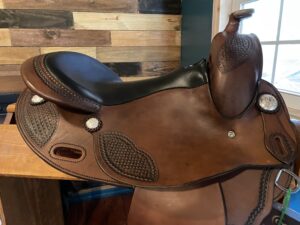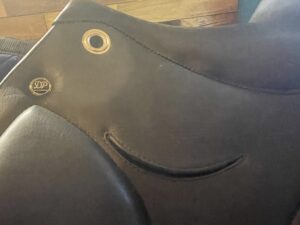New saddles can be a big investment, however, we’ve seen how used saddles may not offer the value expected. If the longevity and selection of a new saddle is appealing to you, there are ways to get the most from your new saddle purchase.
Work with a saddle fitter— A saddle fitter will not only have a clear idea what features your horse will need in a saddle, but they also will be able to assist you in selecting from a variety of brands. Many fitters allow you to try saddles before you buy and some offer a short term return policy. This can save time and money when searching for just the right saddle. No need to ship multiple saddles for trial or buy and sell multiple saddles that don’t fit.
Look for a warranty— Some new saddle brands offer a warranty on saddle workmanship. This feature can help ease concerns about trying a different brand, giving the buyer support for the first several years of saddle life and opening the door to brands not previously considered. A good value can be found this way.
Warranties in the industry often run 1- 5 years. Ask you fitter for details on the brands they carry.
Look closely at materials— The tanning process, quality of hide and thickness of leather can all play into how a saddle wears. Stitching quality will effect how a saddle lasts as well. Where did the leather come from? What do you know about the make of the tree? Your saddle fitter should know about the brands they carry. Work to get the best materials you can afford in your budget. A well made saddle will stay comfortable longer.

Adjustability— The overall shape of the horse rarely changes as much as back width or symmetry. Because of this, if the tree shape fits the horse, often times an adjustable tree and small flocking or panel changes can keep that saddle working with a horse through many changes of shape. This reduces the risk your horse will outgrow the saddle in just a year or two and require you to go through the shopping process again. This is especially valuable in young or rehabbing horses. These horses benefit most from the balance of a well-fitted saddle, but are known to change shape more frequently, leading riders to delay a saddle purchase.
Not all “adjustable” saddles are created the same. Many saddlers say their saddle is adjustable, but how do they mean? Does it have a solid tree and need to be put on a press? These trees can only be changed half a size safely, and if the tree is a classic spring tree or other non-flexible tree the rails of the saddle may not open with the gullet. Also, they must be done by a professional. These changes can be high risk for the tree.
Some brands have a flexible tree and changeable plates. These have proven to be durable systems when well-constructed. They take some time and tools to change, so would work best for a single horse that might only need a plate change a few times a year.
Other brands will use a tool to make a continuous adjustment to the front of the saddle. If the access port is easy to reach, these saddles can be easy to adjust for multiple horses, as long as each horse fits the tree shape and shims are used rather than flock adjustments for individual fitting adjustments. They also work well for hard to fit or “in between sizes” horses, or just riders that like the ease and precision of adjustments.

Maintain your saddle— Once you choose your new saddle, make the commitment to maintain it. Not only is basic maintenance like climate-controlled storage and regular cleaning important, but also regular visits with your fitter. Make sure to get on the correct maintenance cycle for your horse and saddle. By maintaining the flock balance and refreshing flock when needed, the rider can avoid the lumpy or misshapen panels so often found on used saddles. Making sure the saddle continues to fit through changes in your horse’s body will help avoid horse and tree damage. Having billets and webbing checked regularly can help maintain the safety of the saddle. With this regular care a quality saddle can maintain its comfort and usefulness for years to come.
New saddle value = new saddle cost + fitting fees – warranty value – quality construction value/ full 15 years of life
(maintenance costs are important for all saddles, but they will maximize that lifetime)
